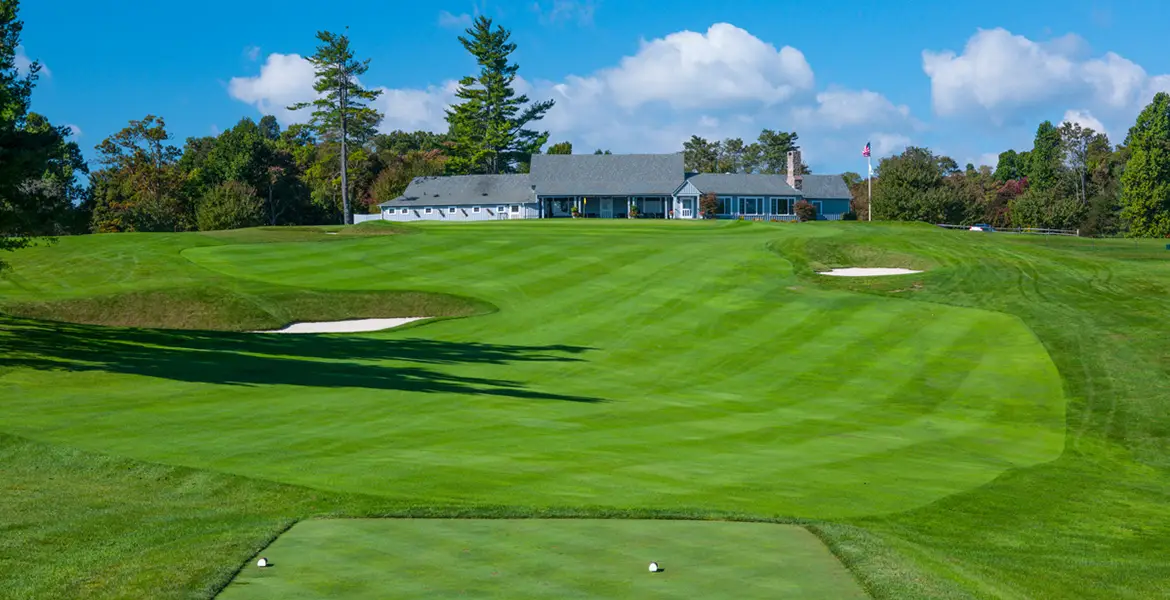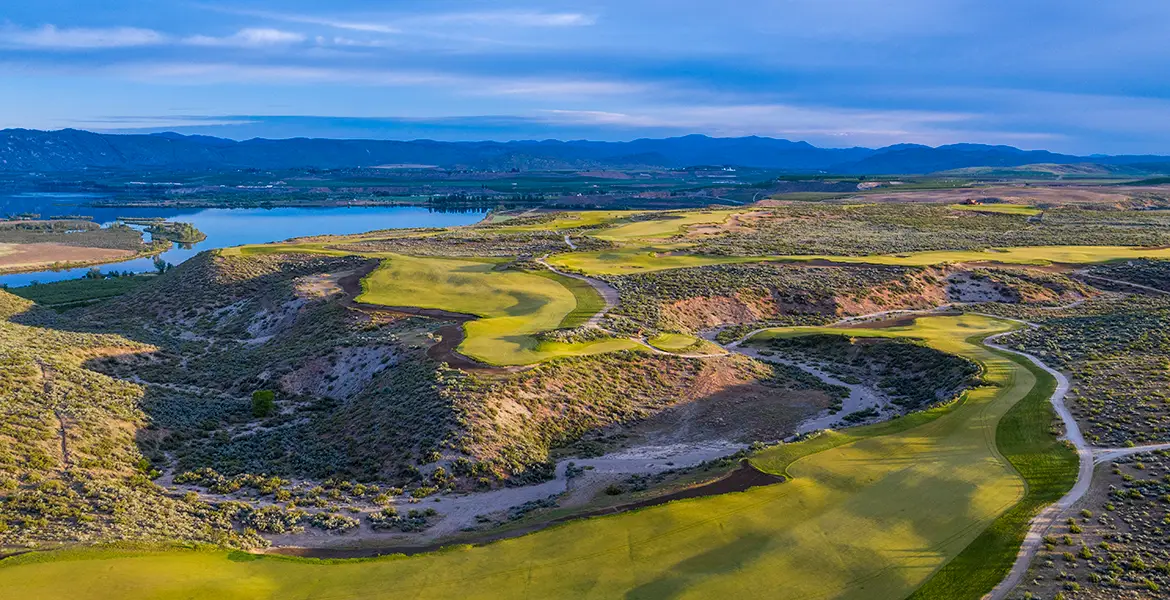Victory for the colonies in the American Revolution brought the burden of solving long-standing territorial squabbles, including a contested boundary between Massachusetts and Connecticut that originally stemmed from faulty British survey work in 1642. Settlement of this dispute produced a deviation in the states’ straight-edged border, a cartological quirk known as the Southwick Jog. Perhaps you’ve spotted it on your highway map during a foliage tour, or a round of college visits with the kids, and wondered about its origins.
In very recent times, a dynamo of a daily-fee golf course has taken shape within this trivia-question tract of land. But there’s been nothing lightweight about the acclaim the new course has received. If you haven’t yet had the pleasure, let this serve as your introduction to The Ranch Golf Club, sited on a former country retreat of the Crane Paper Company clan, barons of the bond-paper industry and developers of cloth-embedded stock that became a U.S. Treasury standard for counterfeit-resistant currency. There’s certainly nothing pseudo about the two-year-old golf facility on the ancestral Crane farmland, from the pegged post-and-beam barns out front to the inspired Damian Pascuzzo golf course flowing from the timbered ridge behind them.
The course laid out by California-based Pascuzzo is a cerebral, sporty and tournament-worthy concoction that rumbles along the base of a north-south ridge then spirals delightfully into wooded uplands. Its mix of cat-and-mouse strategics and occasional calls for raw power combine to make the layout as memorable as a packet of old love letters and as rousing as a Saturday night barn dance. The complex is smoothly managed by Willowbend Development, whose chairman and chief exec is Reebok honcho Paul Fireman—so think of The Ranch as a corporate offshoot of sneakers and stationery.
Commencing his work on the relatively blank canvas provided by subtly pitching dairy land at the base of the big ridge, Pascuzzo drew on classic hole-routing concepts that reward forethought and either lightly scold or sternly admonish grip-and-rip aggressiveness. No. 10, for example, is a Cape-style hole on which the bolder players in our group paid dearly for trying to bite off extra yardage around the dogleg, landing in British-style fescue that ought to produce audible burps, given the way it eats golf balls. Better to play it safe off the tee, since this is one Cape hole that plays comfortably downhill on the approach shot.
Route options and risk-assessment work continues in the high-country holes, although a few of the tighter corridors may leave you thankful for any drive that finds fairway. That said, hit your drive at the par-4 sixth longer and farther left than initially seems necessary. It’s a shortish hole with a beguiling downhill approach, but there’s a sizable patch of fairway on the right from which you would have to hit a high banana-ball around tall trees to reach the green in regulation.
Pascuzzo’s visual style at The Ranch is nicely nuanced. The distinction between his green fronts and the fairways leading up to them can be teasingly blurry. First time around, you are likely to misread the target slightly on a hole or two. Bunker styling is appropriately diverse throughout the course. One particular look—ragged and blowout-style on the far edge, smoothly finished on the near edge—is in obvious favor. In general this is a pleasing design, although in a few spots it seems forced. For the idea to truly work, the outside, ragged border shouldn’t meet up with smoothly graded ground sporting mower-trimmed rough. It should always meld into rugged, unmaintained terrain.
The back nine’s transition hole is No. 11. Here horizontal golf concludes and your siege of the ridge holes begins. As we approached this tee, I was crossing my fingers on behalf of the designer. Holes that connect lowland to upland can sometimes make the golfer feel like a haybale riding a grain conveyor up into the silo. But instead of a get-it-over-with trudge, this par-4 does one the favor of playing shorter off the tee than it looks and legitimately demanding right-side placement of the drive. It concludes with a green complex that is more than worth the trip, the green itself almost comically deep. Full-stroking a putt from the front when I should probably have chipped a 7-iron, I was reminded of the outsized and exaggerated-looking course features you find at boldly original courses from Pine Valley on down the line.
My brother and I chose to walk The Ranch’s adventurous 6,500-yard blue-tee yards and found it a blood-pumping, but by no means heart-pounding, hike. There is only one lengthy green-to-next-tee walk, which is actually what you want. At the Ranch it’s between the eighth green and ninth tee, a hiatus allowing time for how’s-the-family chitchat and a timeout from the heavy brain work needed for club and shot selection.
No. 9 tee, once you arrive, inspires anticipation bordering on glee. Pause here to take in a 40-mile view to the east and white birches gleaming along the fairway borders left and right. You will be tempted to rear back and bomb the drive here, and that’s just what’s advised. Of the two big downhill par-5s—9 and 16, nicknamed “Ski Hill” as a nod to its previous incarnation—this one (at 502 yards from the blues) is more the birdie opportunity, although a bottomland marsh does come between you and the diagonally set green. At a yardage of 578, the 16th likely calls for a drive and a layup, but savor that fairway’s stunning array of mounds, moguls and huge hollows as you descend it.
Putting out on No. 9, first-time visitors get a fresh look at the resplendent yellow barns, one of which has been fully converted to restaurant space. Stop there for a beer and a sandwich, and ask to see the gloriously unrestored interior of its twin while you’re at it.
For a golf course to be exceptional, I’ve lately decided, it has to lower a wispy cloud of bliss upon the golfer somewhere early in its back nine. A hint of rapture must overtake a player, brought on by the routing and the surroundings. The Ranch passes this bliss test, or so it struck me on the tee at No. 15. We had just finished an edge-of-the-property romp of a hole, the dogleg-left 14th, which swings around a sentinel tree and tumbles carelessly downhill to a green that accepts a bounding shot onto the right third of its green and guards the rest of its putting surface with a semi-circle of bunkers (the one front-and-center being dauntingly deep). Even on a first visit, you can feel the course giving and taking in a steady cadence by this point.
Then comes 15, which seems like the heart of the upland collection. The tee shot is slightly uphill to a landing area you can see but you can’t visually chart. The fairway’s right-to-left downward cant is fully revealed as you walk over a rise and survey a narrow, deep green burdened beautifully on the right by a long sweep of land rendered nearly unnavigable by multiple bunkers and a towering oak tree.
To the left is a broad break in the treeline that delivers a heartbreaking view out of the ridgetop, clear out of the Southwick Jog, most likely.
It’s a wonderful nuance of this routing to have the next hole, No. 16, not merely recreate the steep downhill delights of No. 9 but actually top them—at least in the length of the hole and in the size of the fairway hollows, which on 16 are bigger and deeper than backyard swimming pools. It was on this tee we had the thrill in launching that little white piece of sporting goods into the same airspace prowled by colossal Air Force C-130 transport planes, sky-giants that blot the sun as they crawl out of the eastern horizon with surprisingly quiet engines, loaded with dozens of tanks and armored trucks and bound for Westover Air Force Base, 20 miles northwest.
No. 17, faithful to the current fashion, is a par-3 over water to a vast green. We were treated to its toughest pin position—far right, at the low end of the putting surface—and showed our respect by hitting big pulls to a little swath of fairway that caters to cowards and match players who happen to stand at least 2-up through 16. The 18th (to borrow from the basketball game “horse”) is a prove-it par-4 that ducks back nostalgically into the first tier of woodland. This hole provides ample driving space, but rises on a mild upslope to reveal less landing area than the eye of a fretful player would like to see. But No. 18 is really a second-shot hole, playing downhill to a green site that distracts the unfocused golfer by providing a half-acre of fairway-like space pin-high to the right.
This is a popular trick of modern course-building, one I find oddly stimulating. The Ranch’s opening hole goes mad for this little ruse, providing a vast arc of lovely-looking fairway—even mounds and bunkers—miles to the right of where common sense would tell you to play. Its one more little way in which this new layout in an old border town gets into your head, and stays there.






